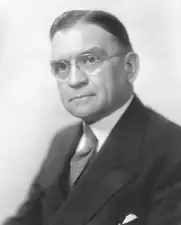Frederick Van Nuys | |
|---|---|
 | |
| United States Senator from Indiana | |
| In office March 4, 1933 – January 25, 1944 | |
| Preceded by | James Eli Watson |
| Succeeded by | Samuel D. Jackson |
| Member of the Indiana Senate | |
| In office 1913–1916 | |
| Personal details | |
| Born | April 16, 1874 Falmouth, Indiana, United States |
| Died | January 25, 1944 (aged 69) Vienna, Virginia, United States |
| Political party | Democratic |
| Alma mater | |
Frederick Van Nuys (April 16, 1874 – January 25, 1944) was a United States senator from Indiana. Born in Falmouth, he attended the public schools and graduated from Earlham College (Richmond, Indiana) in 1898 and from Indiana Law School (now Indiana University Robert H. McKinney School of Law) in 1900. He was admitted to the bar in 1900 and commenced practice in Shelbyville moving shortly afterward to Anderson. From 1906 to 1910 he was prosecuting attorney of Madison County and was a member of the Indiana Senate from 1913 to 1916, serving as president pro tempore in 1915. He moved to Indianapolis in 1916 and continued the practice of law; he was United States Attorney for the U.S. District of Indiana from 1920 to 1922.
According to an interview in the Literary Digest, he pronounced his last name "van-NIECE".[1]
He was elected as a Democrat to the U.S. Senate in 1932, soundly defeating longtime incumbent and Majority Leader James Eli Watson. He was an opponent of the Eighteenth Amendment and called for changes to the Volstead Act.[2] In 1937, he joined with Senator Robert F. Wagner in introducing an anti-lynching bill in the Senate. The House of Representatives passed a similar numbered bill (HR 1507)by a wide 277-120 margin. The bill failed to achieve even a simple majority on either cloture vote in the Senate in 1938 because of the way the Senate Judiciary committee rewrote the bill.
While in the Senate he was chairman of the Committee on Expenditures in Executive Departments (76th Congress) and a member of the Committee on the Judiciary (77th and 78th Congresses).
Although he was a Democrat who was elected as part of Franklin D. Roosevelt’s sweeping victory, Van Nuys was not always a reliable supporter of New Deal policies and opposed the president’s plan to enlarge the United States Supreme Court.[3] He also stayed outside of the Indiana Democratic Party political machine opposing the party in patronage matters.[3] His positions led some forces in the Democratic Party, including the AFL–CIO to oppose his renomination in 1938. Loyalists to Governors Paul McNutt and M. Clifford Townsend sought to "eliminate" him from the Senate, which was welcomed by the Roosevelt administration.[4]
After initially threatening to run as an independent, he secured support for the Democratic nomination and faced Republican newspaper publisher Raymond E. Willis in the general election. Van Nuys won the election by a mere 5,100 votes, which led Willis to appeal to the Senate for a recount, alleging election irregularities. The Senate denied the recount on the grounds that the affected votes would not have changed the results.[5]
In 1943 a confidential analysis by Isaiah Berlin of the Senate Foreign Relations Committee for the British Foreign Office stated of Van Nuys:
his voting record is a very mixed one; in 1939 he was one of the members of the committee which voted to postpone consideration of the Neutrality Act in June of that year; in October he voted for a revision but not for repeal. Like George and Gillette, he is one of the Senators whom the 1938 purge failed to eliminate, and his feeling towards the President is, therefore, somewhat cool. He voted for Lend-Lease in common with most Democrats, against reciprocal trade agreements, and occasionally votes with the Farm Bloc. A man of very uncertain views tinged with isolationism and liable, on the whole, to vote with the Conservatives.[6]
He died on January 25, 1944, at his home in Vienna, Virginia, after a short illness and was buried in East Maplewood Cemetery, Anderson, Indiana. Governor Henry Schricker appointed Samuel D. Jackson to succeed him in the Senate.
See also
References
- ↑ Charles Earle Funk, What's the Name, Please?, Funk & Wagnalls, 1936.
- ↑ "Watson Loses in Indiana Senate Fight". Salt Lake Tribune. 1932-11-09.
- 1 2 "OLD FOES RENEWING FIGHT ON VAN NUYS; Indiana Senator Was at Odds With His Party Machine Before Court Battle Opposition Expected". New York Times. 1937-09-05.
- ↑ "SWING TO VAN NUYS, FOE OF COURT PLAN; His Indiana Rivals, Following Governor's Lead, Back Him for Democratic Convention". New York Times. 1938-07-06.
- ↑ "The Election Case of Raymond E. Willis v. Frederick Van Nuys of Indiana (1939)". United States Senate. Retrieved 2018-08-28.
- ↑ Hachey, Thomas E. (Winter 1973–1974). "American Profiles on Capitol Hill: A Confidential Study for the British Foreign Office in 1943". Wisconsin Magazine of History. 57 (2): 146. JSTOR 4634869.
- United States Congress. "Frederick Van Nuys (id: V000050)". Biographical Directory of the United States Congress.
External links
 Media related to Frederick Van Nuys at Wikimedia Commons
Media related to Frederick Van Nuys at Wikimedia Commons
